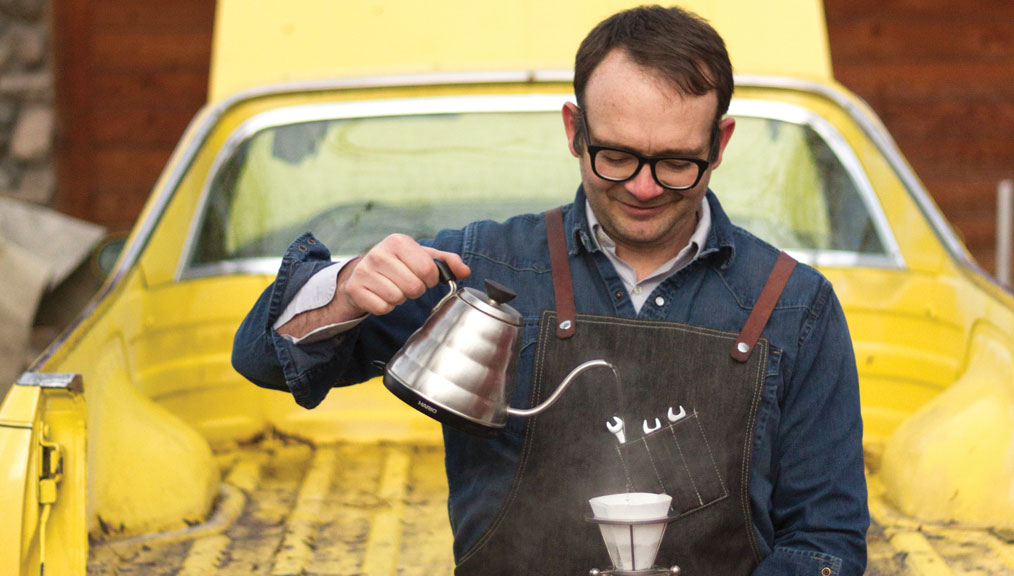(Photo: Andreas Petker.)
[E]ver wonder who dreamed up Alpha Dominche’s Steampunk brewer? Meet Khristian Bombeck. Now a quarter of the leadership team at Saint Anthony Industries, Bombeck and his team have delivered products like the Phoenix70, the Shot Collar, and the Statesman and Levy tamps—not to mention some pretty snazzy aprons.
Bombeck grew up in Alaska, then moved to Bozeman, Montana, to study economics and finance. To fund his education and fuel his snowboarding habit, Bombeck thought it would be fun to open a coffee shop where he could work part-time; it only took a few eighty-hour weeks for him to realize his idealized vision of the coffee world was a bit naive.
After ten years of running the shop in Bozeman with his wife, Heather, Bombeck moved to Salt Lake City, Utah, combining his business, machinery, and coffee expertise in a new endeavor: the Steampunk brewer. Bombeck enlisted the help of brothers Gregory and Ike, and friend Lucas Watts, to launch the company and brewer. Eventually the crew was ready to move on and pursue other interests, and Saint Anthony Industries was born.
This interview has been edited for clarity and space.
After college you decided to open up a coffee house—what drew you to the coffee business?
I used to be into snowboarding, so I would essentially spend nine months out of the year snowboarding on a semi-professional level. I needed to make some sort of income to cover my student loans. I thought by opening a coffeehouse it was something that I could work at part-time and bring some extra money in. It was fun and I don’t have any regrets, but it was definitely naive to think that it was something I could work at ten to fifteen hours a week and enjoy drinking coffee. But I’ve always been into business and the idea of starting a coffeehouse had always been attractive to me. No regrets, I just grossly underestimated the amount of work it would take.
Sounds like it was a good way to get crash-course experience in owning and operating a business.
Like I said, no regrets. It’s a big learning curve. And in Montana at that point, Bozeman was still an agricultural-college-cowboy town. Over the ten years from when I got there to when we left, it was pretty crazy just in terms of the growth and everything. When we first started there wasn’t much coffee available.
Where did your interest in pursuing design and manufacturing come from?
I’ve always been interested in design, but I’ve always loved business too. In college it made more sense to get a degree in economics—I also have a minor in finance. I love the business and the numbers part of it. But then when I opened up my coffeehouse and ended up working eighty hours a week for a couple years to make it happen, ultimately you end up having to design all kinds of things—and I really found satisfaction in that.
Did improving your shop inspire ideas of the directions you could take coffee-related design?
Yeah, exactly. Actually, during that time when I owned our coffee shop, I owned a vintage scooter business as well. I love machines and motors and that kind of stuff. I always had a love for machinery.
Tell me more about working with your brothers and Lucas.
We all worked together at a previous company I started [Alpha Dominche]. When we left, we all left for similar reasons, which was essentially to pursue what our current vision is. We were, and have been, relatively aligned in our vision for how we want to serve the specialty coffee industry. After the last project [the Steampunk] we decided our next project should be focused on boiling all our products and designs to as simple as we can make them while still accomplishing our goals.
I’ve heard murmurs about a new brewing device— El Camino. Can you talk about that?
I’m actually in talks with a major US appliance manufacturer to do a partnership on that. I wish I could talk more about it, but I can’t say more until it goes through. We’ll hopefully have more details and a release date to offer the second quarter of this year.
You guys are always driving to innovate and improve the coffee experience—what does the road ahead look like?
For us, Saint Anthony is a company focused on the specialty coffee experience. But ultimately we want to try to make the specialty coffee experience as easy and attainable and special as we can to a bigger market. There’s a lot of sacrifice associated with having a great specialty experience. Our goal is to lower the level of sacrifice that has to be given. Every item and tool we come out with is something we think can help make specialty coffee easier to attain from a consumer-experience level. Ultimately that’s our bigger idea, but having the opportunity to design and build stuff—to design anything that someone’s going to use—is just a fantastic opportunity in itself. We take great pleasure in that and try to really have fun with it.
—Ellie Bradley is Fresh Cup‘s editor.
















